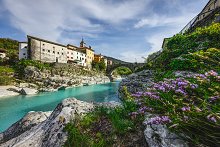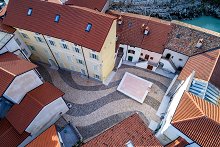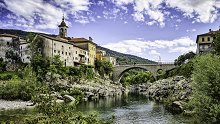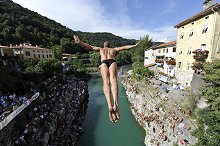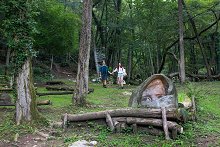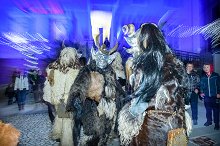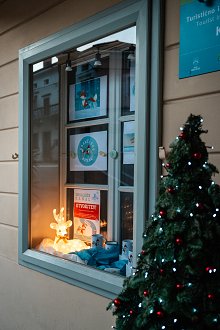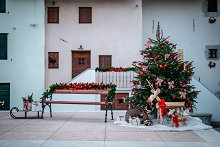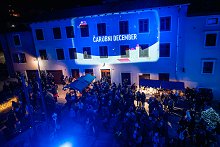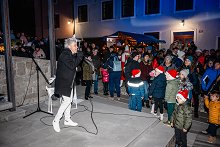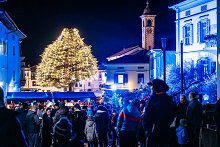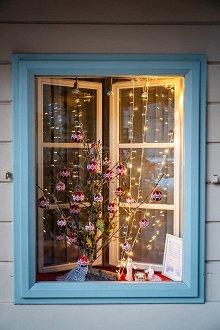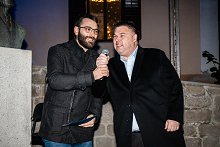Famous personalities
Marij Kogoj (1892 – 1956)
 As a child, the Slovenian composer Marij Kogoj was a self-taught musician. He began composing as early as in 1910, i.e. before he got a formal music education. During 1914 and 1917 he studied composition in Vienna. Although he worked as a successful music critic and private tutor in the Opera House in Ljubljana, his main work was still composing music. His works belong to musical Expressionism. He became popular in two music fields: on the one hand, there is the opera; the opera “Črne maske” (“Black Masks”) is his masterpiece. On the other, there are his solo singings, compositions for choirs and songs for children, which are also well-known. As far as Slovenian musical development is concerned, he is regarded as the first Expressionist. In remembrance of him, every year the international Kogojevi Dnevi Music Festival is held in Kanal.
As a child, the Slovenian composer Marij Kogoj was a self-taught musician. He began composing as early as in 1910, i.e. before he got a formal music education. During 1914 and 1917 he studied composition in Vienna. Although he worked as a successful music critic and private tutor in the Opera House in Ljubljana, his main work was still composing music. His works belong to musical Expressionism. He became popular in two music fields: on the one hand, there is the opera; the opera “Črne maske” (“Black Masks”) is his masterpiece. On the other, there are his solo singings, compositions for choirs and songs for children, which are also well-known. As far as Slovenian musical development is concerned, he is regarded as the first Expressionist. In remembrance of him, every year the international Kogojevi Dnevi Music Festival is held in Kanal.
Valentin Stanič (1774 - 1847)
After the secondary school, Stanič studied theology and philosophy in Salzburg. At the same time, he began practicing Alpine climbing and achieved successes climbing into Salzburg’s mountains. In 1798, he entered in a friary and was ordained as priest in 1802. As he was very excited by his love for mountains, he was the forth inhabitant of the world who climbed into the highest Slovenian mountain Triglav, as well as the first one who measured its sea level. ln 1808, he founded a school in Ročinj. He laid great emphasis on gym, swimming, mountaineering and on all the exercises that strengthen the body. Thanks to his knowledge, he helped people very much, and gave many advises to the sick ones. His greatest merit in the field of medicine is the introduction of vaccinations against smallpox. Stanič was a great, spiritual enlightened person. He laid great stress on school books and thus he also wrote and published his own books. On his initiative, institute for deaf and dumb and a society against animal torturing were founded in Gorica. He also opened the first bookshop, in which religious and educational books were sold. He also had great merits in the introduction of progressing agriculture. He taught farmers how to do various rural works. In 1818, the archbishop of Gorica Jože Wallant called him in Gorica in order to nominate him dean. Today he is remembered as an outstanding man, who worked as a priest, climber, doctor, poet, social worker and farmer. In remembrance of him, a traditional march “Following Valentin Stanič” (“Po stopinjah Valentina Staniča”) from Solkan to Kanal is organized every year.
Riko Debenjak (1908 - 1987)
In February 2008, Kanal celebrated the 100th anniversary of Riko Debenjak’s birth. In order to commemorate the latter, there was an inauguration of his bust in front of the Gallery entrance. The statue was sculpted by the academic Sculptor, Mirsad Begić. The Honourable Speaker at the inauguration was the then Minister of Culture, Dr. Vasko Simonitti.
Pavel Medvešček (1933 - 2020)
 Pavel Medvešček - Klančar was born in Anhovo. After finishing primary school and junior high school in Šempeter pri Gorici, he enrolled in the Ljubljana School of Arts and Crafts, course of Applied Graphics in 1949, from which he graduated in 1955.
Pavel Medvešček - Klančar was born in Anhovo. After finishing primary school and junior high school in Šempeter pri Gorici, he enrolled in the Ljubljana School of Arts and Crafts, course of Applied Graphics in 1949, from which he graduated in 1955.
He worked as a pedagogue and a professional art teacher at primary schools across the Primorska region, and he was also an excellent narrator. During these years, he also attended the Pedagogical Academy in Ljubljana. Later, he got a job working as a preservationist of folk heritage at the Institute for the Protection of Monuments in Gorica, and from 1967 onwards, he worked as a freelance artist and was also actively involved in graphics, painting and illustration.
As an ethnologist, publicist, expert and collector of folk heritage, he published numerous articles and monographs. He also published five books: a collection of fairy tales Na rdečem oblaku vinograd rase (On a red cloud, a vineyard grows, 1990), a book on magical and sacred signs of Primorska, Skrivnost in svetost kamna (The mystery and sacredness of stone, 1992), Obrusnice (1998), Let v lunino senco (A flight into the shadow of the moon, 2006), based on which the national Slovenian television RTV shot two documentaries: Med hribi kačjih glav (Among the hills of snake heads, 2004) and Jelenk – sveta gora starovercev (Jelenk – the holy mountain of ancient believers, 2008). Later, he wrote two other books: Staroverstvo in staroverci: katalog etnološke zbirke Pavla Medvešček (Ancient belief and ancient believers: a catalogue of the ethnological collection of Pavel Medvešček, Medvešček, Skrt 2014) and Iz nevidne strani neba (From the invisible side of the sky, 2015). He also wrote numerous short writings and novelettes.
For decades, his spirit of research was driven by the Soča Valley and the surrounding hills and drawing from the people, he obtained great knowledge about the lives of our ancestors, writing and preserving many of their stories, sometimes modest, sometimes richer, but always shrouded in deep mystery. Five years ago, he portrayed these mysteries in detail in his exquisite ethnographic work Iz nevidne strani neba. At that time, a special exhibition was organized at the Museum of Gorica, which attracted a lot of attention.
He has received several awards for his work. He was Štrekl award laureate and already in the late 1980s, he became a Bevk award laureate for life's work, the award was given to him by the Municipality of Nova Gorica. In 2019, the Municipality of Nova Gorica also awarded him the title of honorary citizenship. In the same way he was honoured in his birthplace too, as he has been an honorary citizen of the Municipality of Kanal ob Soči since 2002.
Ivan Čargo (1898 - 1958)
 Ivan Čargo, a painter, drawer, illustrator and scene painter, was born in the Littoral. After having finished his study in Rome and Florence, in 1924, together with Veno Pilon, Čargo presented his first works at the first art exhibition in Gorica.
Ivan Čargo, a painter, drawer, illustrator and scene painter, was born in the Littoral. After having finished his study in Rome and Florence, in 1924, together with Veno Pilon, Čargo presented his first works at the first art exhibition in Gorica.
He mostly worked as a graphics designer. Among his renowned works, the following shall be included: the portraits of his friends, i.e. composers, artists, writers, architects and actors. In the summit of his production, he produced several caricatures of artistic contemporaries coming from art society. With the growth of unemployment rate, his paintings began representing persons doing degraded and oppressed jobs, i.e. workers, farmers, miners, blacksmiths and rafters.
Marjan Gabrijelčič (1940 - 1998)
Marjan Gabrijelčič, a Composer and Educationalist, was born on 18th January, 1940, in Gorenje Polje. He finished his studies of composition at the Academy of Music in 1966. In 1969, he completed a specialist Post-Graduate study of composition with Professor Lucijan Marija Škerjanc.
His first great successes in composition were linked tightly to Kosovel’s poetry and his native Primorska: Jesen (Autumn), V somrak zvoni (Ringing in the Dusk), Vetri v polju (Winds in the Field), Riba Faronika (Faronika the Fish), Vse je tiho (All is Silent), Marija je rožice brala (Maria was Picking Flowers), Spomin (Memory), Pevcu (To the Vocalist), Koncert za violo in orkester (A Concert for Viola and Orchestra). The Mass for a mixed choir, organs and bells was first written and performed at the 16th Kogoj’s Days in 1995 in Kanal ob Soči.
The Christmas Mass, which was written in homage to Pope John Paul II, will be performed for the first time in public at the 29th Kogoj’s Days with the help of an orchestra, choir and soloists of the SNG Opera Ljubljana.
Štefan Mauri (1931-2014)
Štefan Mauri was born in 1931 in Avče by Kanal. After he had finished Technical School in Ljubljana, he completed the first level of the Faculty of Mechanical Engineering in Reka in 1955. In 1967, he graduated from composition in the class of Professor L. M. Škerjanc. His later life path was interwoven tightly with working as a teacher of professional technical subjects in Ljubljana and Nova Gorica and with active and committed musical work. He achieved some great acknowledgements as a Choirmaster (he led the Chamber Choir in Nova Gorica) while, as a composer, he wrote numerous choral, vocal-instrumental and chamber works. He cooperated actively also in the International Festival of Contemporary Music called “Kogoj’s Days” and received many awards and accolades. In 2010, he received the title of Honorary Citizen of the Kanal ob Soči Municipality.
He passed away in his 83rd year, on 30 December, 2014. He was buried at the cemetery in his home village Avče.
Josip Kocijančič (1849 - 1878)
Josip Kocjančič, a national awakener, Choirmaster, Composer and a Publicist, was born on 16th March 1849 in Kanal.
In 1867, when he was still a very young boy, a sixth grader to be exact, he established a Reading Club in the so-called “torion” (defence tower) at the Križnič Inn. The Reading Club played an important role in the preservation of the Slovenian language, as the Choirs and Dramatic and Recital Societies also operated under the auspices of it. He was a self-taught musician, who managed the Student Choir (their most notorious success was achieved at the great “word” in Gorica) all by himself already as a third grader. In the period from 1869 to 1873, while he was studying Law in Vienna, he ran a choit called Slovenia. He dedicated himself to his studies again in the years from 1875 to 1876 in Gradec, where he led the singing lessons of the Slovenian Singing Society. Later, he founded an excellent Choir-Quartet in Kanal, in which he collaborated with a brilliant baritone.
He gained important choir contributions by giving the incentive for the founding of Slavec - a choir for the entire Gorica - that has brought a qualitative turning point to the singing development of Primorska. He published two collections of Slovenian folk songs for a male choir. His original compositions were published only after his death in a collection entitled as “Čuti v napevih” (Ljubljana, 1881, eight men choirs).
He died in Kanal due to then incurable disease (Tuberculosis) on 10th April, 1878.
Maks Fabiani (1865 – 1962)
Maks Fabiani, a well-known Slovenian architect, professor and urban planner, was born on 29 April 1865 in Kobdilj. He studied architecture in Vienna, graduating in 1892. He was the first architect to obtain a doctorate from the Technical University of Vienna in 1902 and was awarded the title of associate professor in the same year. 1904–1907 he held the position of President of the Austrian Chamber of Engineers and Architects. He designed several important buildings in Vienna, as well as in Ljubljana; the Slovenian (Miklošič) Square, Mladika building, Hribar's House, the base of the Prešeren Monument. In the Primorska region, he designed the Gorica Trade Centre, the Bartoli House in Trieste, the Stabile Palace and the National Hall, and in the Goriška region he designed several sacral buildings. Fabiani's work in the area of the municipality of Kanal ob Soči entailed reconstruction of settlements after the First World War. In Kanal, he was responsible for the urban redevelopment of the main square and the construction of the new municipal building. He also renovated the Križnič inn, the Bavdaž House, the school and the church. In Deskle, he was responsible for the urban planning of the square in front of St. George’s Church, he also considerably extended the square in front of St. Andrew’s Church in Ročinje. He relieved traffic congestion in the centres of the villages Ložice and Kal nad Kanalom by building new bypass roads. Maks Fabiani died in 1962 in Gorica at the age of 98, and his remains lie in the family tomb in Kobdilj.
Anton Nanut (1932 - 2017)
 Anton Nanut studied at the Ljubljana Music Academy. He began his career as a permanent conductor of the Dubrovnik City Orchestra, and built it as a conductor of Slovenian Philharmonic Orchestra and the head of the Conducting Department at Ljubljana Music Academy. He took the philharmonic musicians in Italy, Austria, Belgium, Germany, Poland, the Soviet Republic and to the States. During the period between 1981 and 1998, he was the Chief Conductor of the RTV Slovenia Symphony Orchestra, with which he released more than 30 CDs. He was also in tour in the famous Carnegie Hall in New York, Ciudad de Mexico and in many other European countries. He was a conductor for Dresden Steeatkappelle, the Berlin Radio Symphonic Orchestra, the Mexico City Philharmonic Orchestra and many others. For his artistic work, Nanut received a number of rewards: Carnegie Medal, Smatana Medal and Milano Golden Medal by Milan Concert Association.
Anton Nanut studied at the Ljubljana Music Academy. He began his career as a permanent conductor of the Dubrovnik City Orchestra, and built it as a conductor of Slovenian Philharmonic Orchestra and the head of the Conducting Department at Ljubljana Music Academy. He took the philharmonic musicians in Italy, Austria, Belgium, Germany, Poland, the Soviet Republic and to the States. During the period between 1981 and 1998, he was the Chief Conductor of the RTV Slovenia Symphony Orchestra, with which he released more than 30 CDs. He was also in tour in the famous Carnegie Hall in New York, Ciudad de Mexico and in many other European countries. He was a conductor for Dresden Steeatkappelle, the Berlin Radio Symphonic Orchestra, the Mexico City Philharmonic Orchestra and many others. For his artistic work, Nanut received a number of rewards: Carnegie Medal, Smatana Medal and Milano Golden Medal by Milan Concert Association.
Vinko Vodopivec (1878-1952)
Vinko Vodopivec was born on 16 January 1878 in Ročinj. He was a Roman Catholic priest, musician and composer. After finishing elementary school in Podgora, he attended high school in Gorica and later studied theology. He was chaplain in Kamnje near Vipava and in Črniče near Ajdovščina, then vicar and from 1936 until his death parish priest in Kromberk. His early interest in music was stimulated mainly by his family environment, but he remained largely self-taught, only partly studying with the composer Danilo Fajgl. He devoted himself mainly to church music. His compositions are still an integral part of programmes of church and secular choirs of the Primorska region. He also composed a number of musical dramas (The Blacksmith's Student, Heart and Money, The Singer's Songbook, The Suitors and The Merman). He also wrote instrumental compositions for brass bands and tambourine orchestras. He died in 1952 in Vipava. On the occasion of the 90th anniversary of his birth, members of the Vinko Vodopivec Academic Choir and the inhabitants of Ročinj erected a memorial plaque on his childhood home. It bears the inscription: "From the living springs of the warm homestead, the master drew Slovenian melodies."
(Source: Slovenian Biographical Lexicon, year 2013)
Stanislav Anton Kamenšček (1908-1978)
 Stanislav Anton Kamenšček was born in 1908 in the village of Ročinj. He was a member of the TIGR Organisation and a combatant for the liberation of the Slovenian Primorska. In September 2008, a memorial plaque was erected on his house of birth in grateful remembrance of his actions (the petitioners were the Slovenian Community of Gorica and Krožek Anton Gregorčič).
Stanislav Anton Kamenšček was born in 1908 in the village of Ročinj. He was a member of the TIGR Organisation and a combatant for the liberation of the Slovenian Primorska. In September 2008, a memorial plaque was erected on his house of birth in grateful remembrance of his actions (the petitioners were the Slovenian Community of Gorica and Krožek Anton Gregorčič).
Ivan Gradnik Miklavčič (1680-1714)
Ivan Gradnik – Miklavčič was the military leader of the great Tolmin Revolt in 1713. In April 2008, a memorial was erected at the cemetery in the village of Ročinj. He was convicted and executed in Travnik in Gorica in 1714. His spirit has carved itself into the hearts of the people, while his sacrifice has become a part of our remembrances.
The Leban brothers
Anton Leban, a teacher and pedagogical writer, was born in Kanal on 30 November 1849. He was trained to become a teacher at the Gorica school for teachers, later he taught at schools in Medana, Mozirje, Ribnica na Pohorju, Sežana and Komen. Under the pseudonym Mozirski he contributed to various magazines and newspapers with numerous publications (Edinost, Soča, Slovenski narod). He published several youth novelettes (Povračilo (1875), Knjigotiskarstvo, Čižek, Slavec (1877)) and professional pedagogical articles Vpliv naravoslovja na omiko in blagostanje narodov (The impact of natural science on the good manners and well-being of nations, 1875); Telovadba (Physical exercise); O kazalnem pouku (On demonstrative teaching, 1876); Učitelj – odgojitelj (Teacher – educator); Kako bi se dalo ljudstvo za šolo pridobiti, Nekaj statistike o ljudskem šolstvu v Avstriji (How to convince people in favour of school, Some statistics on public education in Austria). He was the representative of teachers in the Sežana district school council and, from 1881, also the first president of the teachers' association for the Sežana-Komen district. For his work, he was awarded the Meritorious Cross with a Crown and the Meritorious Shrine for his 40 years of service. He died on 12 March 1925 in Stična in the Dolenjska region.
 August Armin Leban, a musician, born in Kanal on 5 September 1847. Like his brother Anton, he was trained to become a teacher at the Gorica school for teachers and worked in Sovodnje ob Soči, Ajdovščina and Gorica. In the field of education, he is well known as a writer of pedagogical articles Kako naj se otrok podučuje v svojem materinem jeziku (How a child should be taught in their mother tongue, 1873), Pismene vaje (Written exercises), Deček in deklica (A Boy and a girl), Važnost deške in dekliške dobe za odgojo (The importance of boyhood and girlhood for upbringing). He composed church and particularly secular songs. He only published a few songs in the newspaper Učiteljski tovariš and Vrtec (1876, no. 2–4, annexes). He died on 30 May 1879 in Gorica. His compositions were posthumously published by his brother Janko: Pet cerkvenih pesmi za moški zbor (Five Church Songs for the Male Choir, 1880), Glasi s Primorja (Voices from Primorje, 1881), Skladbe Avgusta Arminina Lebana (Compositions by August Armnin Leban, 1883–1891),Venec ipavskih narodnih pesnij (Wreath of Ipavian folk songs, 1883), Pobožni vzdihi (Divine sighs, 1885). Avgust Leban actively cooperated with Josip Kocijančič from the Gorica choir Slavec and was involved in the Kanal reading association. The latter has repeatedly included Leban 's poems in its programme, for example Slovenska deklica (Slovenian girl).
August Armin Leban, a musician, born in Kanal on 5 September 1847. Like his brother Anton, he was trained to become a teacher at the Gorica school for teachers and worked in Sovodnje ob Soči, Ajdovščina and Gorica. In the field of education, he is well known as a writer of pedagogical articles Kako naj se otrok podučuje v svojem materinem jeziku (How a child should be taught in their mother tongue, 1873), Pismene vaje (Written exercises), Deček in deklica (A Boy and a girl), Važnost deške in dekliške dobe za odgojo (The importance of boyhood and girlhood for upbringing). He composed church and particularly secular songs. He only published a few songs in the newspaper Učiteljski tovariš and Vrtec (1876, no. 2–4, annexes). He died on 30 May 1879 in Gorica. His compositions were posthumously published by his brother Janko: Pet cerkvenih pesmi za moški zbor (Five Church Songs for the Male Choir, 1880), Glasi s Primorja (Voices from Primorje, 1881), Skladbe Avgusta Arminina Lebana (Compositions by August Armnin Leban, 1883–1891),Venec ipavskih narodnih pesnij (Wreath of Ipavian folk songs, 1883), Pobožni vzdihi (Divine sighs, 1885). Avgust Leban actively cooperated with Josip Kocijančič from the Gorica choir Slavec and was involved in the Kanal reading association. The latter has repeatedly included Leban 's poems in its programme, for example Slovenska deklica (Slovenian girl).
 Janko Leban, teacher, writer, poet and musician, born on 21 April 1855 in Kanal. He began to attend school in Gorica and graduated from the school for teachers in Koper. He worked as a teacher in several places across Goriška and Kranjska. His debut Tolba ptice (Tolba birds) was published in 1870 by the periodical Jadranska zarja. The following year, when he was a third-grader, he published a collection Pesni in povesti za pokušnjo (Poems and tales to taste). The small book of the then 16-year-old boy attracted a lot of attention, and the politicians and national awakener dr. Karel Lavrič praised him and paid for his printing costs. Poems, novelettes and informative articles were published by Leban in the periodicals Zora, Edinost, the Calendar of the Mohor society, Slovenskemu narodu and Učiteljevemu tovarišu. In later years, he published several poetry collections. In addition, he became well known as a writer of pedagogical articles and discussions, e.g., Zakaj se muzika po pripravnicah skrbno goji? (Why should music be carefully cultivated in preparatory school?, 1873), Materni jezik v slovenski ljudski šoli (Mother tongue in Slovenian folk school), Človek v pogledu na njegovo telo in dušo (Man in view of his body and soul,1886) and a series of biographies (about his brother August Leban, Hrabroslav Volarič, Josip Kocjančič, Jakob Petelin Gallus, Andrej baron Čehovin). Like his brother, he took an active part in the reading association and dedicated a poem to it on the 35th anniversary of its functioning in 1902 entitled Svojim rojakom (To my countrymen). He died on 18 February 1932.
Janko Leban, teacher, writer, poet and musician, born on 21 April 1855 in Kanal. He began to attend school in Gorica and graduated from the school for teachers in Koper. He worked as a teacher in several places across Goriška and Kranjska. His debut Tolba ptice (Tolba birds) was published in 1870 by the periodical Jadranska zarja. The following year, when he was a third-grader, he published a collection Pesni in povesti za pokušnjo (Poems and tales to taste). The small book of the then 16-year-old boy attracted a lot of attention, and the politicians and national awakener dr. Karel Lavrič praised him and paid for his printing costs. Poems, novelettes and informative articles were published by Leban in the periodicals Zora, Edinost, the Calendar of the Mohor society, Slovenskemu narodu and Učiteljevemu tovarišu. In later years, he published several poetry collections. In addition, he became well known as a writer of pedagogical articles and discussions, e.g., Zakaj se muzika po pripravnicah skrbno goji? (Why should music be carefully cultivated in preparatory school?, 1873), Materni jezik v slovenski ljudski šoli (Mother tongue in Slovenian folk school), Človek v pogledu na njegovo telo in dušo (Man in view of his body and soul,1886) and a series of biographies (about his brother August Leban, Hrabroslav Volarič, Josip Kocjančič, Jakob Petelin Gallus, Andrej baron Čehovin). Like his brother, he took an active part in the reading association and dedicated a poem to it on the 35th anniversary of its functioning in 1902 entitled Svojim rojakom (To my countrymen). He died on 18 February 1932.
Vojeslav Mole
 Slovenian art historian, archaeologist, preservationists, professor and poet was born on 14 December 1886 in Kanal. He studied art history and archaeology at the universities of Vienna, Krakow, and Rome, and, in 1912, he obtained his doctorate in Vienna. He worked as a professor at the universities of Ljubljana and Krakow. He published two poetry collections: Ko so cvele rože (When the flowers were blooming, 1910) and Tristia ex Siberia (1920). At times, he published under the pseudonym Spitignjev. He also wrote reviews and Slovene and art essays. Vojeslav Mole connected the Poles and Slovenes with his critical and essayistic work. In 1966, he moved to the United States, he died on 5 December 1973 in Oregon.
Slovenian art historian, archaeologist, preservationists, professor and poet was born on 14 December 1886 in Kanal. He studied art history and archaeology at the universities of Vienna, Krakow, and Rome, and, in 1912, he obtained his doctorate in Vienna. He worked as a professor at the universities of Ljubljana and Krakow. He published two poetry collections: Ko so cvele rože (When the flowers were blooming, 1910) and Tristia ex Siberia (1920). At times, he published under the pseudonym Spitignjev. He also wrote reviews and Slovene and art essays. Vojeslav Mole connected the Poles and Slovenes with his critical and essayistic work. In 1966, he moved to the United States, he died on 5 December 1973 in Oregon.
Ludvik Zorzut
 Poet, cultural worker, mountaineer and mountaineering publicist, born on 24 August 1892 in Medana. He started writing as a high-school student, was an enthusiastic mountaineer, a tourist worker, and led the choir in Medana. Above all, he was a very active publicist and poet, he worked culturally and ethnically, published articles and records of various kinds: travel journals, folklore and mountaineering articles. He cooperated with almost all Primorska magazines, newspapers, anthologies and calendars, as well as with Maribor newspapers, and permanently with Planinski vestnik and the Calendar of the Goriška Mohor society as well as the Calendar of the Mohor Society. As a poet, he did not publish any collection, however, in 1974 the Mohor Society published a collection of his poems under the title Ptička briegarca. In addition to his native Brda, the landscapes in Zorzut's writing are also the Vipava Valley, the Venetian Slovenia, part of Posočje, Cerkljansko and Pohorje. His poetry is ethnographic and written in dialect. In April 1949, he had to leave Gorizia and Italy because the authorities did not recognize his Italian citizenship. He moved to Kanal ob Soči and lived there until his death on 27 April 1977.
Poet, cultural worker, mountaineer and mountaineering publicist, born on 24 August 1892 in Medana. He started writing as a high-school student, was an enthusiastic mountaineer, a tourist worker, and led the choir in Medana. Above all, he was a very active publicist and poet, he worked culturally and ethnically, published articles and records of various kinds: travel journals, folklore and mountaineering articles. He cooperated with almost all Primorska magazines, newspapers, anthologies and calendars, as well as with Maribor newspapers, and permanently with Planinski vestnik and the Calendar of the Goriška Mohor society as well as the Calendar of the Mohor Society. As a poet, he did not publish any collection, however, in 1974 the Mohor Society published a collection of his poems under the title Ptička briegarca. In addition to his native Brda, the landscapes in Zorzut's writing are also the Vipava Valley, the Venetian Slovenia, part of Posočje, Cerkljansko and Pohorje. His poetry is ethnographic and written in dialect. In April 1949, he had to leave Gorizia and Italy because the authorities did not recognize his Italian citizenship. He moved to Kanal ob Soči and lived there until his death on 27 April 1977.
